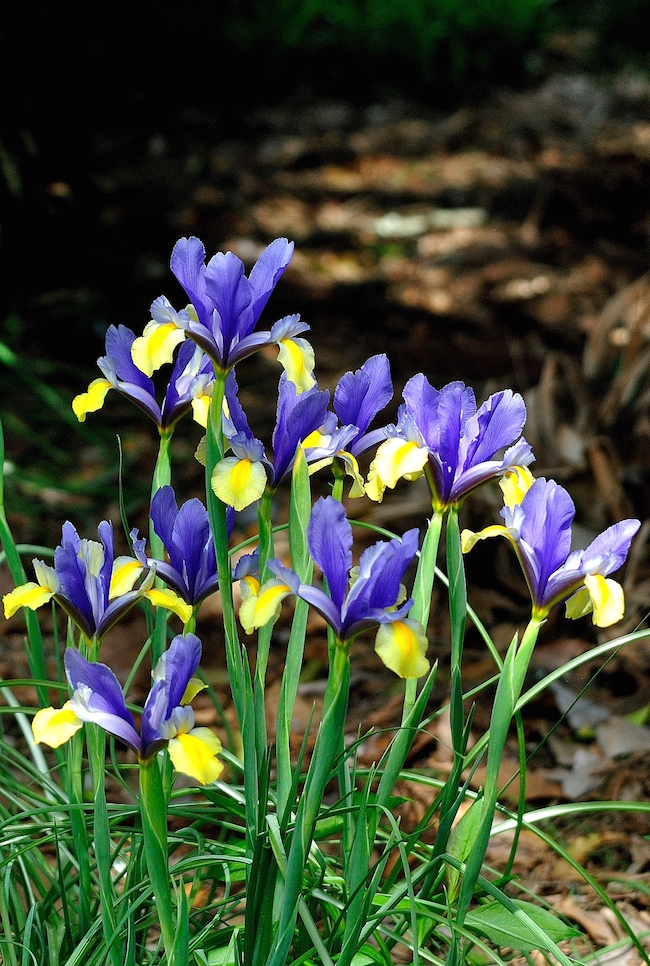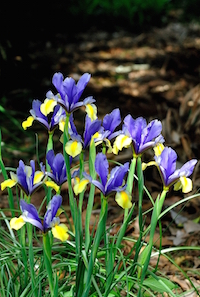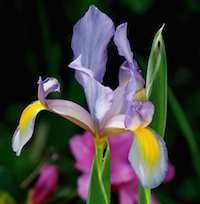The word on the street (I’ve always wanted to say that) is that the Dutch iris is a short-lived perennial. Tell that to ‘Romano,’ an incredible, showy bloomer that we have in the Coastal Georgia Botanical Gardens that was planted in the late 1990s. I’ve led a life comparable to a house flipper, so my personal experience with the longevity of perennials has been by word-of-mouth or reference book to say the least, but it seems to me anything approaching 20 years would rate as awesome.
The Dutch iris has been relatively trouble-free here in Savannah, Georgia, and our Telstar variety, which is blooming now, is bringing out the cameras. It has been in the ground for three years and is naturalizing wonderfully well. Most years our Dutch irises bloom from late March through April; yours may bloom in May and June. They are so beautiful and easy to grow, I told Stan Gray of Gray’s Iris Garden fame that, in addition to all of the thousands of Louisiana irises he is planting, we need every Dutch iris we can get our hands on.
That is when my eyes were opened to the complexity of this group. First off, when I typed it in my favorite search engine, it asked if I meant “Dutch Irish.” Holy ancestry! Then, when I convinced the search engine that I was talking about plants, I quickly came to realize this is the most famous iris that florists use in cut flowers. Then I typed in “Iris hollandica” and “Iris x hollandica,” the names on our tags, and nope, even those are not officially recognized.
To cut to the chase, the Dutch iris is a group that has beginnings in Spain, Morocco, Portugal and other Mediterranean countries with the Iris xiphium. The resulting hybrids with I. tingitana, I. latifolia and I. lusitanica have resulted in garden bulbs that bloom with both rare beauty and structure.
As mentioned above, the Dutch iris is a bulb as opposed to a rhizome. Most references suggest a cold hardiness of zones 6 through 9, but it’s not hard to see gardeners touting a return in zone 5 when a protective layer of mulch has been added. They need plenty of sun to bloom their best, though a little afternoon shade would be tolerated.
The soil should be fertile and very well drained. It stands to reason, if I am raving about the beautiful blooms now, that fall is the best time to plant. It is possible that you may find container-grown plants this spring, in which case take advantage and get them established in your landscape.
Otherwise, you will want to plant bulbs 3 to 5 inches deep. Almost every reference suggests planting them 3 to 5 inches apart, or up to 12 bulbs per square foot. In Savannah our plants are vigorous, reaching 36 inches, so a wider spacing of 8 to 12 inches makes me a little more comfortable. Massing your planting definitely gives the best show. Leave the foliage until it dies after the bloom, much like you would with daffodils. This ensures sufficient energy for next year’s blooms.
If the dying foliage is problematic for your display, plan for their disguise. For instance, if you look at our blooming Telstar iris now, you see a blooming loropetalum and the blue-fruited mahonia. What you don’t see are the perennials that will come up, screening the old iris foliage. One of my friends in Mississippi created quite a showy display with the exquisite Wedgewood Dutch iris, Louisiana phlox and daffodils. It’s really simple – just plan for a rotation of color through the seasons.
At the gardens, we have Louisiana irises, tall-bearded irises, spuria irises, pseudata irises, native irises and Japanese roof irises. But I can tell you, when the Dutch irises are blooming, they will compete for camera time. I hope you will give them a try in your landscape too!
Follow me on Twitter @CGBGgardenguru. Learn more about UGA’s coastal garden at www.coastalgeorgiabg.org/.









